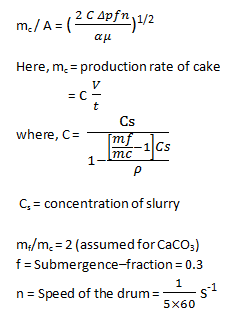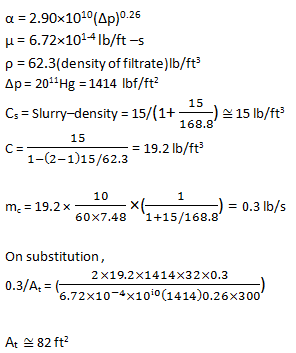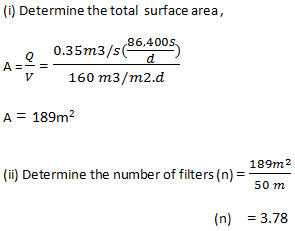1. What does the term Positive pressure means?
a) The contaminants of the room should not flow out into the surrounding
b) There should be the balance between the room and surrounding of air and contaminants
c) The pressure makes room isolated from the surrounding and contaminants
d) The air pressure is lower than the surrounding
Explanation: Positive pressure refers to pressure that exceeds the surrounding pressure of any room, chamber or confined space. Positive pressure is maintained in a closed zone to ensure no outside contaminated gaseous or liquid substance can get into that protected zone.
2. For which phase filter aid is used to filter?
a) Gas and liquid
b) Solid and Liquid
c) Gas
d) Gel
Explanation: Filtration is the separation of solids from liquids by forcing the liquid to flow through a porous medium and depositing the solids on the medium. A filter aid (finely divided material added to the liquid to be filtered) helps control flow and solids removal.
Precoat filtration is a type of mechanical filtration that can be used to clarify liquids. Filter aids such as diatomaceous earth, perlite and cellulose enables a liquid to pass through while retaining the haze-causing particles.
3. “Filter aid can also be added to the fermentation broth to increase the porosity of the cake as it forms”, what does this statement means?
a) To increase the pH of the fermentation broth
b) To decrease the filtration rate
c) To decrease the pI of the fermentation broth
d) To increase the filtration rate
Explanation: The additive should provide a thin layer of solids having high porosity (0.85 to 0.90) over the filter medium’s external surface. As Suspension particles will ideally form a layered cake over the filter aid cake layer. The high porosity of the filter aid layer will ensure a high filtration rate. Porosity is not determined by pore size alone. High porosity is still possible with small size pores.
And at high pH and low pI the proteins will not denature and not coagulate and therefore more aggregates will not be formed so there will be less filtration rate.
4. Is plate frame filter a batch filter?
a) True
b) False
Explanation: It is a batch filter so in between batches time wastage is considerable. Batch discharge after each cycle requires detailed consideration of ways of receiving and storing cake, or of converting it to a continuous stream for delivery to an ultimate disposal method.
5. A rotary drum filter with 30% submergence is used to filter concentrated aqueous slurry of calcium carbonate containing 15lb of solids per cubic foot of water. The pressure–drop is 2011Hg. If the filter cake contains 50% mixture (wet basis), calculate the filter area required to filter 10 gal/min of slurry. The filter cycle time is 5 min. The specific cake resistance depends on the pressure–drop as:
α (ft/lb) = α (Δp)0.26, where α = 2.90×1010
Viscosity of the filtrate = 6.72×10-4 lb/ft-s. Density of calcium carbonate = 168.8 lb/ft3. Neglect filter medium resistance.
a) ≅ 88 ft2
b) ≅ 86 ft2
c) ≅ 82 ft2
d) ≅ 90 ft2
Explanation: The expression for the production rate of cake.


6. A city is to install rapid sand filters downstream of the clarifiers. The design loading rate is selected to be 160 m3/ (m2.d). The design capacity of the water works is 0.35 m3/s. The maximum surface per filter is limited to 50 m2. Design the number and size of filters.
a) 189 m2, 4.78
b) 189 m2, 3.78
c) 167 m2, 2.66
d) 167 m2, 2.78
Explanation:

7. A city is to install rapid sand filters downstream of the clarifiers. The design loading rate is selected to be 160 m3/ (m2.d). The design capacity of the water works is 0.35 m3/s. The maximum surface per filter is limited to 50 m2 and find out the normal filtration rate?
a) 154.3 m3/(m2.d)
b) 154.6 m3/(m2.d)
c) 155.6 m3/(m2.d)
d) 155.3 m3/(m2.d)
Explanation: Select four filters .
The surface area for each filter is, a = 189 m2/4 = 47.25 m2
We can use 7 m×7 m or 6 m×8 m or 5.9 m×8 m (exact)
If a 7 m×7 m filter is installed, the normal filtration rate is
V = Q/A = (0.35 m3/s×86,400s/d)/(4×7 m×7 m) = 154.3 m3/(m2.d)
8. Microfiltration can be used to remove viruses.
a) True
b) False
Explanation: Microfiltration cannot be used to remove viruses as a microfiltration filter has a pore size around 0.1 micron, so when water undergoes microfiltration, many microorganisms are removed, but viruses remain in the water. Ultra filtration would remove these larger particles, and may remove some viruses.
9. What type of filter does not come under the Membrane filters?
a) Ultra filtration
b) Microfiltration
c) Precoat (filter aid) filtration
d) Nanofiltration
Explanation: A filter cake is formed by the substances that are retained on a filter. The filter cake grows in the course of filtration, becomes “thicker” as particulate matter is being retained. With increasing layer thickness the flow resistance of the filter cake increases whereas membrane filters do not use any filter aid.
10. What do you mean by the term ”Backwashing”?
a) Excluding intermittent use of compressed air during process
b) Is a form of destructive maintenance
c) Washing at the backside of the filter
d) Including intermittent use of compressed air during the process.
Explanation: In terms of water treatment, including water purification and sewage treatment, backwashing refers to pumping water backward through the filters media, sometimes including intermittent use of compressed air during the process. Backwashing is a form of preventive maintenance so that the filter media can be reused.